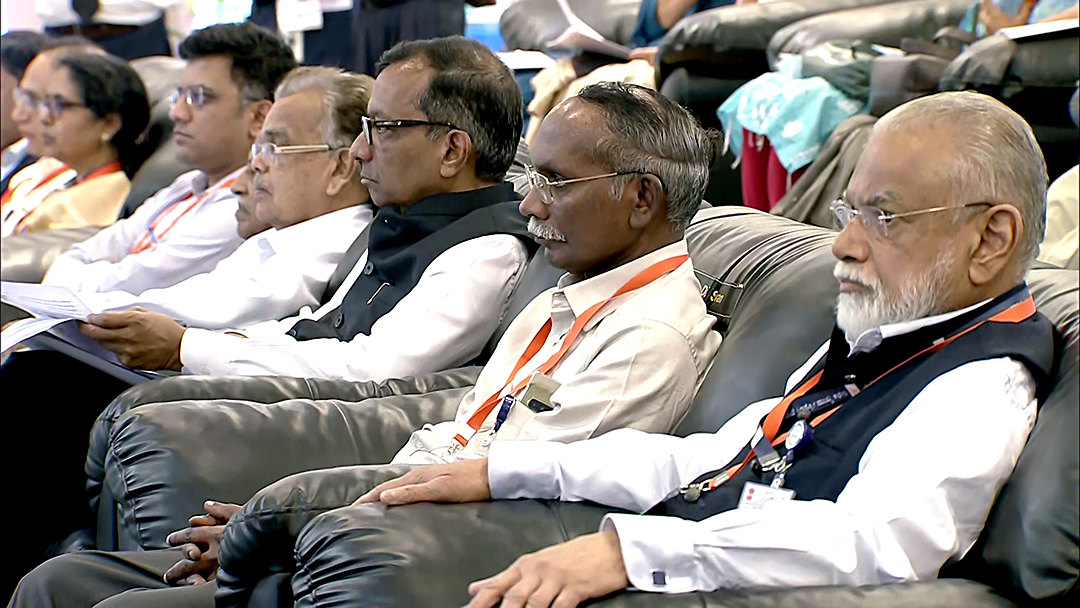K. Sivan was the chief of the Indian Space Research Organisation (ISRO) at the time of the Chandrayaan-2 mission, launched in 2019….reports Asian Lite News
As Chandrayaan-3 achieved a soft landing on the South Pole of the moon, making India the first country to reach that particular area, former ISRO chief K Sivan on Wednesday said that it is sweet news, for which they have been waiting for the last four years.
“We are really excited to see this grand success. For this, we have been waiting for the last four years. This success is sweet news for us and for the entire nation,” K Sivan said.
Sivan was the chief of the Indian Space Research Organisation (ISRO) at the time of the Chandrayaan-2 mission, launched in 2019.
The country’s second lunar mission was only “partially successful” since the lander lost contact, in the last moments when a distance of 2.1 km was left, and made a hard landing on the surface of the moon. Following this, the then ISRO chief Sivan broke into tears.
Meanwhile, as the Chandrayaan-3 lander module Vikram made a safe and soft landing on the Moon, the ISRO chief S Somanath said, “India is on the Moon”.
Responding to Chandrayaan-3’s success, Sivan said that the Central government is also with us and they also will be happy to see this happy moment.
On the world, closely watching this mission, he said, “Chandrayaan-3’s science data is not only for India, it is for the global scientists.”
“The scientists will use this data globally to discover new things from it,” he added.
Meanwhile, former Professor of the Indian Institute of Astrophysics (IIA) RC Kapoor, said, “This is the best moment of my life and we can’t express our excitement as it landed. This is the moment to congratulate ISRO, the whole nation and the entire world…”
He said that this opens the floodgates to research and increase activity in the Southern part of the moon.
“India is now one of the four topmost space agencies of the world,” the astronomer added.
Officials at India’s space agency ISRO headquarters in Bengaluru broke into applause after the Vikram began its powered vertical descent towards its landing site.
Prime Minister Narendra Modi who is attending the 15th BRICS Summit in Johannesburg watched the live telecast and as soon as the touchdown happened he sported a big smile and waved the tricolour.
The countdown of the Vikram hovered at 150 metres, then 130 metres, and 50 metres and decelerated as approached the moon’s service before finally touching down on the lunar surface.
As the Vikram lander carrying the Pragyaan rover in its belly touched down on the lunar surface, it marked a giant leap in India’s spacefaring journey providing a well-deserved finale to ISRO’s long years of toil.
This makes India the fourth country – after the US, China, and Russia – to have successfully landed on the moon’s surface, it has earned a place in record books as the first to touchdown on the south side of Earth’s only natural satellite.
Billions of people across India and globally closely monitoring the much-awaited event. More so after Russia’s Luna-25 spacecraft crashed on Sunday after spinning out of control.
In the run-up to the scheduled soft landing of Chandrayaan-3, people across the country prayed to God in all denominations of places of worship for a successful mission.
Special screenings of the soft landing were organized across the country, including schools and science centers, and public institutions. ISRO made the live actions available on the ISRO website, its YouTube channel, Facebook, and public broadcaster DD National TV.
The scheduled timing for the soft landing of Chandrayaan-3 on the moon’s south pole on August 23, 2023 (Wednesday), was 18:04 IST, with the powered descent of Vikram lander at 1745 IST.
ISRO had been releasing a series of up-close images of the moon, assisting the lander module in determining its position (latitude and longitude) by matching them against an onboard moon reference map.
Historically, spacecraft missions to the Moon have primarily targeted the equatorial region due to its favourable terrain and operating conditions. However, the lunar south pole presents a vastly different and more challenging terrain compared to the equatorial region.
The spacecraft was launched from the Satish Dhawan Space Centre in Andhra Pradesh’s Sriharikota on July 14.
A GSLV Mark 3 (LVM 3) heavy-lift launch vehicle was used for the launch of the spacecraft that was placed in the lunar orbit on August 5 and since then it was through a series of orbital manoeuvres been lowered closer to the moon’s surface. (ANI)

